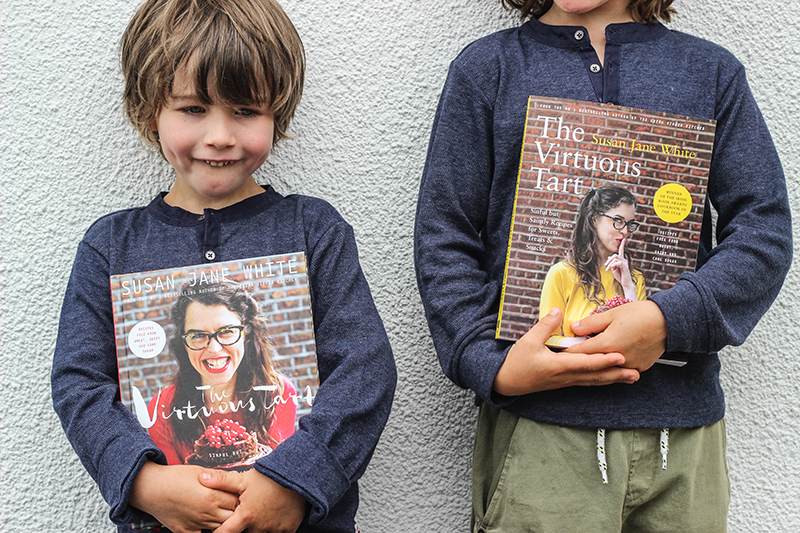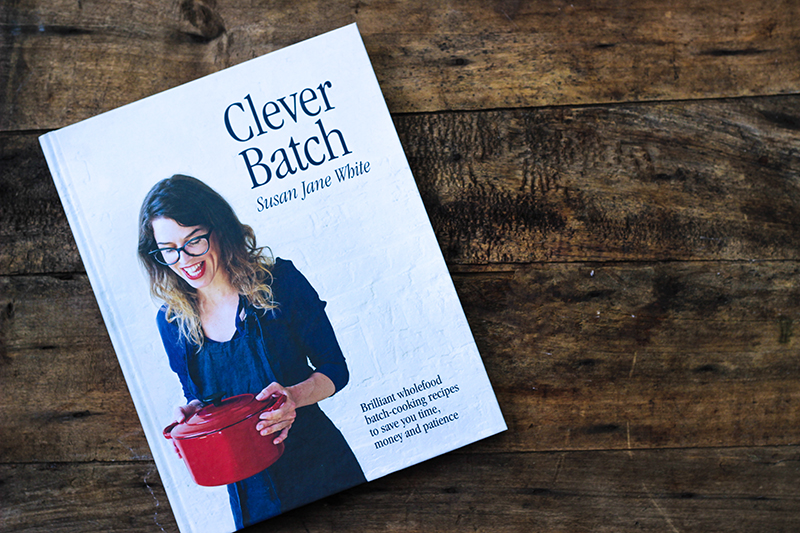From Tasty. Naughty. Healthy. Nice. cookbook, © 2017 by Susan Jane White. Reprinted by arrangement with Roost Books, an imprint of Shambhala Publications, Inc. Boulder, CO.
Chapter 1 from the cookbook …
My name is Susan Jane. Picture MacGyver in an apron with a grumpy husband who thinks he’s a restaurant critic and two ravenous little punks to feed six times a day. Food is my thing, it keeps me happy. People say my energy level would rival Serena Williams on acid.
But I wasn’t always so bionic.
Thirteen years ago I was a college student in Dublin, and later at Oxford University. Juggling deadlines, booze-ups, and tutorials was a skill in itself. If I could fit them all in without expiring, surely I was doing fine, right?
Looking back, I could never get enough sugar hits; I was an addict. Everything I did related to or led to my next sugar fix. I even convinced myself that college projects required gallons of coffee and pounds of Curly Wurlies to charge my brain cells, that I couldn’t possibly perform without them.
Sound familiar?
I never saw myself as someone who needed to change. After all,there was nothing out of the ordinary about my “Western” diet: jam-filled scones, toast, pasta, breakfast cereals, toast, take-out sandwiches, and more toast. Standard Irish fare. No wonder I tried to regulate my moods with criminal amounts of caffeine.
Let’s be honest: consumers are highly submissive. I hardly thought to ask any questions about the ingredients in my energy drink or the Monster Munch I devoured with the giddy determination of a clamper spotting a Bentley in the bus lane. I blindly trusted the “food authorities,” whoever they were, and I never imagined that beef burgers, for example, might contain horsemeat, that chicken products could test positive for pork, or that our modern diet would lead millions into “diabesity.” Like Alice in Wonderland, I was jumping feet first into a deep, dark rabbit hole. Except this was no tea party.


First we form habits … and then they form us. It wasn’t alcohol or cigarettes that ruined my health. It was food. Junk food. I convinced myself that only boring people had time to cook. Turns out, smarter people make time to cook.
In the summer of 2005 my body said no, enough. First came the shakes. Horrid urinary infections. Constipation. Mouth ulcers. Exhaustion. But nobody suggested that maybe I was contributing to my ill health. My digestive system wheezed like an asthmatic snail, yet diet apparently had nothing to do with it. Ten years ago the medical community dismissed the idea of gut sensitivities like tycoons scoffing at global warming. Contemplating such an idea was daft. After all, test results had shown I was not celiac or diabetic. Case closed.
The chronic conditions started to make themselves at home. Thrush. Earaches. Dizziness. Psoriasis. Headaches. Cold sores. But I didn’t have time to respect the symptoms and turned to self-medication.
I had papers to submit. There was literally no time to be sick.
I ended up in the hospital, with tubes coming out of. . . well, everywhere. They sent in doctor after doctor. As the consultants handed me their cards, I noticed the letters after their names kept getting longer and longer. Yet no one could figure out why my body was as limp as wet lettuce. I was numb, physically and emotionally.
After twelve courses of antibiotics, several hospitalizations, a course of steroids, anti-fungal colon treatments, and many futile vaccinations, I felt unlucky but in no way responsible. Then my white blood cells packed up.
One afternoon in the hospital, I got to chatting with an elderly lady called Lucy in the cubicle next to me. I wasn’t certain why Lucy had been admitted. She was frail but so sweet in her papery mint gown, smiling back over the sheets. We talked for hours. I cried inside when she asked to hold my hand to give her strength. Lucy cooed about her love of bread making, yet she was celiac (so her body could not handle gluten). I remember thinking how strange that was: ignoring the signals her system was sending.
Across the room, another patient was tucking into jelly and ice cream from the hospital canteen. She was being treated for “complications” arising from diabetes and obesity. It was like death on a plate, and in a horribly ironic twist, the hospital staff were her accomplices. The sight sent a chill up my arms. Both women knew their poison but chose to ignore it. They were digging their way to their graves with their teeth. A little later, I heard a loud, flat bell. Doctors and nurses ran in and sectioned me off from Lucy. I never saw her adorable face again. No one did.
The following morning I looked in the mirror, and what I saw made me cry. I turned away from the mirror, and in that instant — a wrenching minute of pure self-knowledge, accompanied by a sort of grief for the person I was now saying good-bye to — I made the most important decision of my life: to take control of my health. Raising my head, I looked into that mirror once again. And I nodded.
Deal.

My nutritional pilgrimage started with a journey to Dr. Joe Fitzgibbon, an Irish GP who specializes in diet and fatigue.
It was a six hour round-trip for every visit. Together we tackled the Elimination Diet, stripping my meals to very basic foods like meat, fish, pulses, beans, and vegetables. It’s not rocket science. In fact, it’s pretty bloody obvious, right? But there’s “nothing common about common sense,” Dr. Fitzgibbon observed. Every couple of weeks I reintroduced specific foods to my diet to monitor symptoms, like a food detective. It felt like someone was sucking the illness out of my body.
That austere diet made me see the intimate connection between energy levels and the food we eat. Good food keeps you on your tippy toes. Poor food will have you on your knees. So I waved good-bye to all manner of processed food. That was 12 years ago.
The first three weeks were horrific. I don’t want you thinking I was running barefoot through fields of cornflowers, throwing my arms around trees in a state of orgasmic self-enlightenment. Nor did I ever choose to give up junk food. I had to. My body was falling apart. There was no other choice.
So I tramped around health food stores with a mixture of confusion and nervous elation, like an ornithologist sighting a new species of bird. All the time I was busy mourning for Diet Cola Girl. “Jesus, I could buy a bottle of wine for the price of that kombucha” and “I can’t afford that weirdo flour, it’s three times the price of the regular stuff!”
Eventually I realized there is nothing restrictive about this way of eating. It’s the opposite. This was an empowering opportunity to escape the shackles of processed food and the excesses of the Wheat-Sugar-Dairy merry-go-round. There are legions of grains, flours, and beans to experiment with in place of boring pasta and bread. And instead of lobbing butter into my mouth ten times a day, I now discovered variety from a suite of other healthy fats like walnut, coconut, sesame, and hemp seed oils. Discovering this wealth of options was my second lightbulb moment. My “restrictive” diet was nothing of the sort. It was incredibly liberating.

By continuing to feed our bodies with one-dimensional foods made from white sugar, white flour, and industrially produced chemicals, we condition our brains to accept crap. Breaking the habit is challenging, but once you experience the benefit of eating whole, unprocessed foods, you will never look back. Make no mistake: it’s a love affair like no other. But don’t just take my word for it.
See for yourself.

Eating well is intuitive. You already have the secret to wellness. You don’t need a crew of neurotic food fascists on Instagram telling you what to eat.
There are thousands of dynamite wholefoods to choose from. Herewith are my favorite recipes. Don’t worry—I won’t threaten you with cabbage soup or Lycra tights. These recipes are less about denial and more about pleasure: they are for joy-inducing foods, like banana malt ice cream, raw chocolate tortes, chestnut crêpes, smoky black bean bowls, spicy pomegranate noodles, and homemade pine nut ricotta.
If you approach this book with a sense of adventure, I bet your palate will be tickled and your mojo will return. In time your weight will stabilize, you will sleep more soundly, and hum louder. But there’s more! We now know that a healthy diet significantly reduces your risk of developing heart disease, many cancers, and type 2 diabetes. If there was a pill promising the same, wouldn’t you want to take it? Whole-food cooking isn’t a pill. It’s a ticket.

Of course you shouldn’t have to give up wheat, sugar, dairy, or any other food group in order to eat well. Everyone has different needs and different poisons. That’s what makes humans so damn charming. For me, it’s about expanding my choices—choices that I was never exposed to before. But whatever your reasons for exploring new and nourishing foods away from the circus of convenience, you are very welcome to my kitchen.
Let’s do this together.

Tasty. Naughty. Healthy. Nice is now available in the US, wherever good books are sold. With over 140 wholefood recipes for all the family, you can expect your pots and pans to levitate with giddiness. Here are some links to popular online American vendors.





7 Comments
ABSOLUTELY BRILLIANT I am a huge fan…ordering it today! CONGRATULATIONS SJW
Thanks for your lovely message Cate! Namaste! xxSJW
Hi, is the Extra Virgin Kitchen and this book Tasty, Naughty, Healthy, Nice, th same book? They have the same picture on the front and some of the same recipes I can see on the advert on Amazon.
I love your books, ralaly inspiring. I do not, however want to buy the same book twice.
Best wishes. Angela xx
Hi Angela – yes they are! No need to buy it twice! This is the US edition x SJW
What a lovely message to receive Cate, thank you and Namaste! x SJ
Wow- what an introduction. I think it’s good to include the message that it doesn’t necessarily mean giving up food groups. I’m a coeliac, eat some butter & yoghurt, try to minimise (but don’t eliminate) sugar, and feel I’m doing pretty OK on that! The issue of cost is interesting, and demands consideration in terms of society as a whole. It’s easy for me as a middle-class employed person to purchase foods in the health food store that are more expensive, but we need to look at the benefits of readily available more inexpensive foods too for those on a lower budget, combined with education on nutrition/cooking (why is this not a part of our school curriculum yet?) and encouraging growing your own food for individuals and communities.
So true! It’s painful to see the lengths we have to go yet, especially difficult for larger families with working parents and a fundamental lack of resources. What is the answer?! Thanks for your comments. Onwards ye of admirable tenacity! SJ